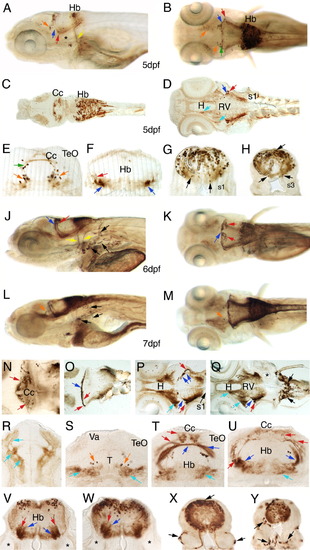
Anti-YFP immunostainings of hoxb4a enhancer detection larvae at 5 dpf (A-H), 6 dpf (J, K), and 7 dpf (L-Y). The arrows have the following color code. Red, blue: 2 precerebellar fiber tracts; orange: cells in ventral tegmentum; green: cells in cerebellum; light blue: fiber tract projection towards tectum. The yellow and black arrows are explained below. A,B: Whole-mount larvae at 5 dpf. The yellow arrow marks a nerve innervating the fin. C,D: Horizontal sections through a 5-dpf larva on level of the dorsal hindbrain/cerebellum (C) and ventral hindbrain (D). E-H: Transverse sections through a 5-dpf larva. The black line frames a tangential stripe pattern of YFP-positive neurons. The black arrows point to neurons in the ventral hindbrain and to a neuroepithelial cell located dorsally. J,K: YFP distribution in 6-dpf larvae. The left yellow arrow points to the vagal nerve, the right yellow arrow marks a nerve innervating the fin. Black arrows point to neural crest cells. L,M: Anti-YFP-stained larvae at 7 dpf. Black arrows mark neural crest cells. N-Q: Horizontal sections through 7-dpf larvae, in a row from dorsal to ventral. The black arrows mark cells around the somites. R-Y: Transverse sections through a 7-dpf larva, in a row from anterior to posterior. The lateral and ventral black arrows point to cells around the somites and the dorsal black arrow to a single stained neuroepithelial cell. The asterisk marks the inner ear. D, diencephalon; Cc, corpus cerebelli; H, hypothalamus; Hb, hindbrain; Rv, rhombencephalic vesicle; s1, first somite; T, midbrain tegmentum; TeO, tectum opticum; Va, Valvula cerebelli.
|

